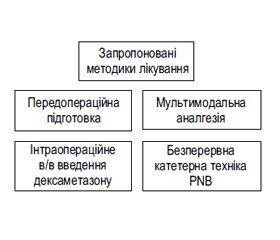Журнал «Медицина неотложных состояний» Том 21, №2, 2025
Вернуться к номеру
Рикошетний біль: фактори ризику, запропоновані методи лікування
Авторы: Дмитрієв Д.В. (1–3), Сірош В. (2, 3), Ткачук М. (4)
(1) - Вінницький національний медичний університет імені М.І. Пирогова, м. Вінниця, Україна
(2) - Центр термічної травми та пластичної хірургії, Вінницька обласна клінічна лікарня імені М.І. Пирогова, м. Вінниця, Україна
(3) - Центр лікування болю та реабілітації «Прометей», м. Вінниця, Україна
(4) - Чернівецька лікарня швидкої медичної допомоги, м. Чернівці, Україна
Рубрики: Медицина неотложных состояний
Разделы: Справочник специалиста
Версия для печати
Рикошетний біль визначається як «транзиторне гостре посилення післяопераційного болю, яке виникає після закінчення дії блокади периферичного нерва (PNB)» або як явище, при якому спостерігається кількісна різниця у балах болю, коли PNB працює, порівняно з тим, коли її ефект зникає. Факторами, пов’язаними з підвищеним ризиком рикошетного болю, є: молодший вік, жіноча стать, ортопедичні/травматологічні оперативні втручання, відсутність періопераційного внутрішньовенного введення дексаметазону. Рикошетний біль — один із негативних наслідків регіонарної аналгезії. Пацієнтів необхідно інформувати про цей синдром під час передопераційного огляду анестезіолога, як і про інші відомі ускладнення та наслідки кожного виду знеболювання. Запропоновані схеми лікування, такі як безперервні катетерні методики PNB, мультимодальна аналгезія, інтраопераційне введення дексаметазону, потребують подальших досліджень для визначення найбільш ефективної стратегії лікування.
Rebound pain is defined as “a transient acute increase in postoperative pain that occurs after the end of peripheral nerve block” (PNB) or as a phenomenon in which there is a quantitative difference in pain scores when PNB is active compared to when its effect disappears. Factors associated with an increased risk of rebound pain are younger age, female gender, orthopedic/traumatic surgery, and lack of perioperative intravenous dexamethasone. Rebound pain is one of the negative consequences of regional analgesia. Patients should be informed about this syndrome during the preoperative examination by an anesthesiologist, as well as about other known complications and consequences of each type of anesthesia. The proposed treatment regimens, such as continuous catheter techniques of PNB, multimodal analgesia, and intraoperative dexamethasone administration, require further research to determine the most effective treatment strategy.
регіонарна анестезія; рикошетний біль; блокада периферичного нерва; післяопераційний біль; мультимодальна аналгезія
regional anesthesia; rebound pain; peripheral nerve block; postoperative pain; multimodal analgesia
Для ознакомления с полным содержанием статьи необходимо оформить подписку на журнал.
- Williams BA, Bottegal MT, Kentor ML, Irrgang JJ, Williams JP. Rebound pain scoresas a function of femoral nerve block duration after anteriorcruciate ligament reconstruction: Retrospective analysis of a prospective, randomized clinical trial. Reg Anesth Pain Med. 2007;32:186-92. [PMC free article] [PubMed] [Google Scholar]
- Demarco JR, Componovo R, Barfield WR, Liles L, Nie-tert P. Efficacy of augmenting a subacromial continuous-infusion pump with a preoperative interscalene block in outpatient arthroscopic shoulder surgery: a prospective, randomized, blinded, and placebo-controlled study. Arthroscopy. 2011;27:603-10. [PubMed] [Google Scholar]
- Lavand’homme P. Rebound pain after regional anesthesia in the ambulatory patient. Curr Opin Anaesthesiol. 2018;31:679-84. [PubMed] [Google Scholar]
- Park JY, Bang JY, Oh KS. Blind suprascapular and axillary nerve block for post-operative pain in arthroscopic rotator cuff surgery. Knee Surg Sports Traumatol Arthrosc. 2016;24:3877-83. [PubMed] [Google Scholar]
- Abdallah FW, Halpern SH, Aoyama K. Will the real benefits of single-shot interscalene block please stand up? A systematic review and meta-analysis Lavand’homme P. Anesth Analg. 2015;120:1114-1129.
- Garrett S. Barry, Jonathan G. Bailey, Joel Sardinha, Paul Vishal Uppal. Factors associated with rebound pain after peripheral nerve block for ambulatory surgery.
- Latremoliere A, Woolf CJ. Central sensitization: A generator of pain hypersensitivity by central neural plasticity. J Pain. 2009;10:895-926. [PMC free article] [PubMed] [Google Scholar]
- Admassie BM, Tegegne BA, Alemu WM, Getahun AB. Magnitude and severity of rebound pain after resolution of peripheral nerve block and associated factors among patients undergoes surgery at University of Gondar comprehensive specialized hospital northwest, Ethiopia, 2022. Longitudinal cross-sectional study. Ann Med Surg. 2022;84:104915. [PMC free article] [PubMed] [Google Scholar]
- Narinder P Singh, Jeetinder K Makkar, Janeesha K Chawla, Rakesh V Sondekoppam, Preet M Singh. Prophylactic dexamethasone for rebound pain after peripheral nerve block in adult surgical patients: Systematic review, meta-analysis, and trial sequential analysis of randomised controlled trials.
- Henningsen MJ, Sort R, Moller AM et al. Peripheral nerve block in ankle fracture surgery: a qualitative study of patients’ experiences.
- Goldstein RY, Montero N, Jain SK, et al. Efficacy of popliteal block in postoperative pain control after ankle fracture fixation: a prospective randomized study. J Orthop Trauma. 2012;26:557-561.
- Muñoz-Leyva F, Cubillos J, Ki Jinn Chin. Managing rebound pain after regional anesthesia.
- Kuchyn Iu, Horoshko V. Predictors of treatmentfailure among patients with gunshot wounds andpost-traumatic stress disorder. BMC Anesthesiol. 2021;21(1):263. doi: 10.1186/s12871-021-01482-8. (https://pubmed.ncbi.nlm.nih.gov/34717551/).
- Kuchyn Iu, Horoshko V. Pain syndrome inpatients with gunshot wounds of the limbs and post-traumatic stress disorders. Medicina neotložnyh sostoânij. 2021;17(7):24-31. Ukrainian (https://doi.org/10.22141/2224-0586.17.7.2021.244591).
- Dmytriiev D. Assessment and treatment of postoperative pain in children. Anesthesia, Pain and Intensive Care. 2018;22(3):392-400. (https://www.apicareonline.com/index.php/APIC/article/view/63)
- Dmytriiev D, Dmytriiev K, Stoliarchuk O, Semenenko A. Multipleorgan dysfunction syndrome: what do we know about pain management? A narrative review. Anesthesia, Pain and Intensive Care. 2019;23(1):84-91. (https://www.apicareonline.com/index.php/APIC/article/view/1003)
- Dmytriiev D, Dobrovanov O. Post-COVID pain syndrome. Anesthesia, Painand Intensive care. 2021;25(4):505-512. (https://doi.org/10.35975/apic.v25i4.1582)

